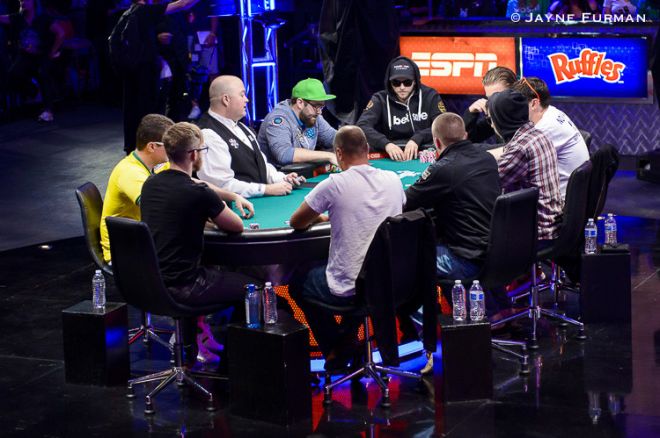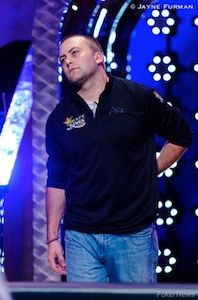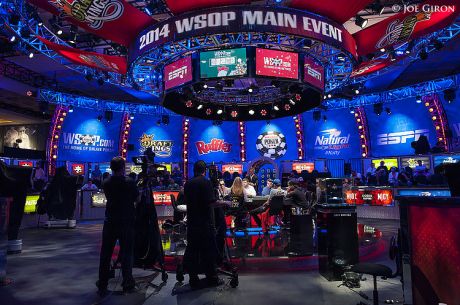2014 WSOP Main Event Hand Analysis: Final Table Elimination Hands Review

After last night��s November Nine marathon, they are down to just three players in the 2014 World Series of Poker Main Event. There were a number of intriguing hands among the 244 played last night, but as we prepare to watch Jorryt van Hoof, Martin Jacobson, and Felix Stephensen return tonight to battle for the title, let��s look in particular at the six hands that took us from nine players down to three.
Hand #56: Mark Newhouse Elimination, 9th Place
The blinds were 250,000/500,000 with a 50,000 ante. Jorryt van Hoof opened for 1.1 million from the hijack with 8?7?. Mark Newhouse called from the cutoff with 10?10?, then William Tonking three-bet to 3.75 million from the small blind with Q?Q?. Van Hoof got out of the way and Newhouse made the call.
The flop came J?4?2?. Tonking led out for 3.5 million and Newhouse called. Tonking would then check the 4? turn and Newhouse bet 4.5 million. Tonking made the call. The river was the J? and Tonking checked again. Newhouse moved all in for 10.2 million and after thinking it through for a bit Tonking made the call to eliminate Newhouse in ninth place for the second straight year.
Review: This is the elimination hand from last night that will receive the most discussion and rightfully so.

Newhouse could have done himself a world of favors by three-betting the hyper-aggressive van Hoof preflop which would have led to a likely four-bet from Tonking and subsequent fold from Newhouse.
Instead Newhouse chose the alternate path of just calling and having position on the solid Tonking, a decision that would be justifiable as part of a plan not to lose too much postflop. You could then make an argument for Newhouse folding to the smallish bet from Tonking on the flop, but I like his calling there to see what Tonking does on the turn.
It��s the turn where my thinking and Newhouse��s differ. When Tonking checks, I would prefer checking behind to get to showdown as cheaply as possible. Tens have value here if Tonking has a hand like AxKx and you don��t want to give Tonking an opportunity to check-raise you off of your hand.
Newhouse elects to bet and Tonking makes the call. That might have told Newhouse where he stood, but he elected to move all in for over 20 big blinds on the river when the likelihood of inducing a fold was small. Newhouse probably understood that it was the only way he could win the pot, but that chance was slim enough he should have just taken the safe way out and checked behind.
Hand #100: Bruno Politano Elimination, 8th Place

With the blinds at 300,000/600,000 with a 75,000 ante, it folded to Bruno Politano on the button who moved all in with Q?10? for 8.1 million (13.5 big blinds). Felix Stephenson made the call from the big blind with 7?7?.
The board ran out 6?3?2?K?9? to send the likable Brazilian to the rail.
Review: A pretty standard spot here with a short-stacked Politano moving all in first to act from the button. I��m one of those players who thinks that moving all in with greater than 10-BB stacks to pick up the blinds and antes is a bit much, but the math backs up the play so it is certainly justifiable. Stephenson��s call is also standard given the dynamics of the play.
Hand #106: Dan Sindelar Elimination, 7th Place

The blinds were still 300,000/600,000 with a 75,000 ante and Stephenson opened to 1.3 million from early position with A?10?. Van Hoof was next to act and made it 3 million to go with A?3?. It was folded to the short-stacked Dan Sindelar who moved all in for 9.15 million with J?J? from the button. The blinds and Stephenson folded and after some deliberation and with plenty of chips to gamble, van Hoof called.
The flop moved van Hoof into the lead as it came A?7?2?, pairing van Hoof��s ace and leaving Sindelar drawing to the J?. The turn was the 3? and the river the Q?, giving van Hoof the pot and eliminating Sindelar.
Review: Here is a classic example of the big stack getting his hand caught in the cookie jar then having to make a call due to the price he was getting. The three-bet preflop is a bit aggressive, especially in earlier position with a marginal suited ace. But once van Hoof puts in the 3 million he really has no choice but to call the additional 6.15 million after Sindelar moved all in. There was nearly 15 million in the pot, so he was getting close to 2.5-to-1 on his money to make the call.
Stephenson��s fold is an easy one, although it would have been interesting to see how he would have responded if Sindelar had not shoved. The all-in push from Sindelar was absolutely correct and he was unfortunate to run into the hot hand of van Hoof.
Hand #140: Andoni Larrabe Elimination, 6th Place

The blinds had increased to 400,000/800,000 with a 100,000 ante. Van Hoof opened for 1.8 million from the button with K?5?. Andoni Larrabe then moved all in for 8.325 million from the small blind with J?10? and van Hoof made the call.
The board ran out K?8?3?8?6? to eliminate Larrabe in sixth place.
Review: This hand perhaps illustrates a lack of patience on the part of the youngest player at the final table. It also offers a lesson regarding final table dynamics. While J?10? is a good hand under many circumstances, it��s not one you should be willing to risk your last 10 big blinds with when there has been a raise in front of you.
If Larrabe was first to act the shove would have been fine, but there was no way he was going to get a fold from the chip leader and thus was going to have to most likely rely on hitting one of his cards or drawing a straight or flush to survive.
Hand #208: Billy Pappas Elimination, 5th Place

Hand #208 didn��t quite send Billy Pappas home, but it left him with just 50,000 chips (less than a single ante) so it is effectively the hand that ended his Main Event run. The blinds were 500K/1M with a 150,000 ante and it was folded to Jacobson on the button who moved all in for 24.425 million with 5?5?. Pappas then moved all in from the small blind for just a little more with A?J?.
Pappas would lose the hand when the board ran out Q?6?5?7?2?, and Van Hoof would subsequently knock Pappas out in Hand #209.
Review: I��m not a huge fan of open-shoving for 24 big blinds as you��re usually only getting called by something that beats you. If Jacobson has no plans on folding to a three-bet, however, the shove is fine as it prevents him from having to second-guess himself.
Given the over-shove, Pappas had to think he was at worst racing. However, I still think a fold could be found here as I don��t see Jacobson pushing here with anything less than a pair or big ace.
Hand #224: William Tonking Elimination, 4th Place

The blinds were still 500K/1M with a 150,000 ante. First to act, van Hoof opened for 2.2 million with Q?7?. Tonking moved all in from the button with 2?2? for 20 million, then Martin Jacobson reraised all in for slightly more than that from the small blind with 10?10?, and van Hoof stepped aside.
Tonking would pick up many outs after the J?5?4? flop and 6? turn, but the river was the Q? to send the last American in the field to the rail.
Review: Take this with a grain of salt as I��m merely an observer of the action, but I was surprised at the lack of patience displayed by some of the players at the final table, and Tonking��s elimination capped the evening with one last example.
Perhaps frustrated by how often van Hoof was opening, Tonking decided to take a stand. I don��t think you have to take a stand for your whole stack, however, especially when there are still two players left to act. If he had been in the big blind and was closing the action, then the shove makes more sense. But I��d have preferred to utilize position here and either flat the opener or make a small reraise.
Avoiding becoming impatient is easier said than done, of course, particularly amid the intense pressure of 12 hours�� worth of poker at the final table of the game��s most prestigious event. With three especially strong players left with a shot at the bracelet, tonight��s action should present still more interesting strategic decisions.
Get all the latest PokerNews updates on your social media outlets. Follow us on Twitter and find us on both Facebook and Google+!








